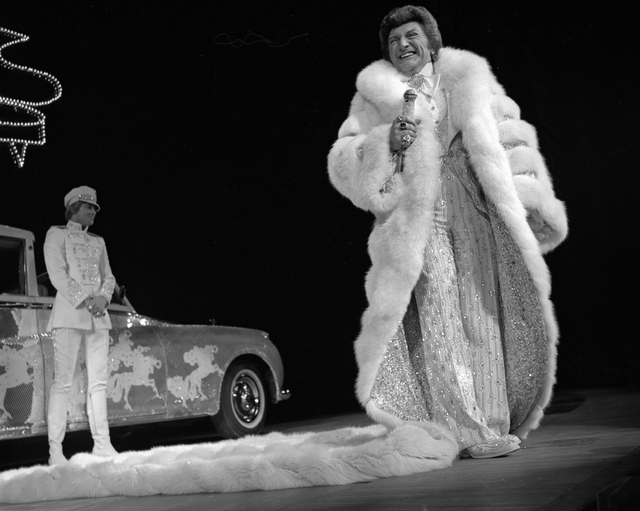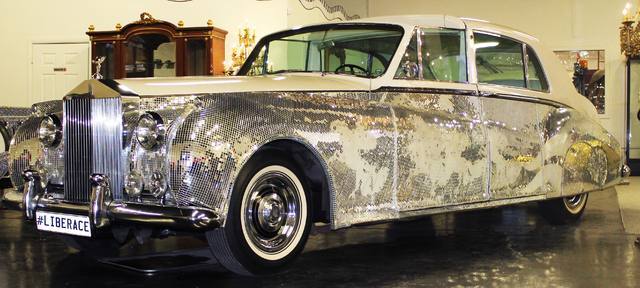Liberace Foundation’s Jonathan Warren: Entertainer epitomized Las Vegas



The spate of show closings here has made everybody sit up and take notice. What’s wrong? Where’s the showmanship? Where’s the spectacle? Why are theater rooms getting smaller? Why are audiences getting thinner at the box office? Why do shows last less time than bringing back ice from the supermarket?
Think back to a golden era of The Rat Pack and superstars such as Elvis Presley and Frank Sinatra. “Mr. Las Vegas” Wayne Newton remembers those days as exemplified in his new run of shows at Windows Showroom at Bally’s as he recalls the glory days. These were the stars and shows with longevity.
In talking with Jonathan Warren, chairman of The Liberace Foundation for the Performing and Creative Arts who has lived here for nearly 50 years, I learned that Liberace’s image as a hologram is returning to the Strip, and the same image of the original superstar will be seen in an upcoming Hollywood movie.
Liberace is alive again. Jonathan also is honorary consul of the Principality of Monaco, and he remembers Liberace’s career, a falsely exaggerated fortune and magical day back in the ’80s when I was here coincidentally for ENTERTAINMENT TONIGHT interviews that included a visit with Mr. Showmanship:
On a bright summer afternoon in 1981, I gripped the steering wheel of my annoyingly small Pontiac, the ink still drying on the driver license I’d obtained that morning. Then 17, I had picked up the car from my father at the UNLV faculty office he had occupied since 1969. Heading west, I halting at what was then a four-way stop sign at barren Harmon and Swenson.
A car on my left crossed northward in front of me. The passenger in the red sedan looked tired, his elbow resting against the window, his cheek resting against his hand, as the bespectacled driver slowly past in front of me. The well-dressed passenger and I made eye contact as he seemed to be deep in thought. I recognized him immediately. It was Liberace.
It wasn’t so astonishing to see the performer. He was a very approachable star in the neighborhood, known to me then for always being friendly, gracious in public and giving away full-size candy bars on Halloween.
Life away from the stage
What was more surprising was the conservative Oldsmobile he rode, nothing like the unbelievable custom Rolls-Royces or crystal-covered Duesenberg in which he always arrived onstage here or in New York. I realized that those cars were an extension of his stage costumes.
Though future performances wouldn’t reflect it, by that time Liberace had every reason to look as tired as he did. He had held the record as the highest-paid entertainer in the world from 1955 to 1978. Still packing them in, he was performing nonstop in Las Vegas and abroad, entering an era from which performers would draw from the science of showmanship he developed.
His restaurant called Tivoli Garden and The Liberace Museum adjacent to it were among Las Vegas’s most visited attractions drawing locals and tourists. At the time, I realized little more than the fact that he was a big star and a symbol of Las Vegas.
The Las Vegas in which I grew up seemed to me to be almost a product of Liberace. Glittering signs of that pre-reader board era were certainly drawn from the glittering costumes of Liberace and all those who had imitated his form of showmanship. Only much later did I learn the depth of the impact he had on my hometown, on showmanship itself and on entertainment in general.
Seven years later, Liberace was gone. Among the first of the celebrities lost to AIDS, at a time when any mention of the disease struck panic at a fever pitch, bigotry, lawsuits, discrimination and often witch hunts in the media. The public’s recoil from the news left a depressing absence of the public mourning worthy of such an icon.
Despite 30 years of sold-out Las Vegas shows and unmatched public generosity, it would not matter that the Library of Congress would later cite only Liberace as the personality representative of Las Vegas culture.
Legacy begins to fade
The lights of the Strip never dimmed for its own Liberace. Although he had left his fortune and rights to his foundation, frustrated fans and preservationists struggled to keep his memory alive. The legacy of Liberace slowly faded.
By the time I was asked to join the board of directors of The Liberace Foundation, it had expended its endowment fund, closed The Liberace Museum years before, had virtually no income and was crushed by overhead.
Having been told in hushed tones by a previous chairman that the foundation had been endowed with $88 million of Liberace’s $110,000 million estate, I fully expected to uncover massive graf when I took over as chairman in 2014. I had heard stories of disputes and theft by former associates. But as my new team dug out financial archives, I soon found out otherwise.
Ever the showman, Liberace appears to have planted the seed of the $88 million myth. The total of the assets with which he endowed The Liberace Foundation was around $8.8 million (about half of it in cash and the other his museum collection) from a total estate of $11 million.
In keeping the myth of the higher figure, foundation directors subjected themselves to unwarranted scrutiny and accusation, all for the purpose of bolstering the legend of great wealth, which itself had served to bring crowds to his museum.
The Liberace Foundation awarded more than $6 million in scholarships to some 2,700 students at 100 universities over 30 years before closing the endowment fund. The myth is more evidence of the tremendous showmanship of Liberace. The more I got to know Liberace, the more brilliant I realized that he was. I also found that I was not alone.
Tim McCraw, Eminem, Tupac Shakur, Dr. Dre, Jay-Z, Lady Gaga, Rick Ross and hundreds of other artists have named Liberace in lyrics of songs, his artifacts will be exhibited at European museums, and he’ll make a guest appearance in an upcoming Hollywood blockbuster. Soon to perform with major stars, his brand will be licensed in ways larger and more elegant than he could’ve imagined.
And now, the spectacular cars which carried him onstage here and in New York, as well as costumes and other artifacts from his shows and his showroom at his museum, can be a visit or event at Liberace Garage. The newly developed space inside Hollywood Cars Museum on Dean Martin Drive is open daily from 10 a.m. to 5pm.
So when you visit the latest Liberace Museum, consider that you could have your next celebration amid the rides that put him in the spotlight, under the chandeliers of his residencies. Remember how the King of Bling rolled. And be proud of him, Las Vegans. He’s all ours.












